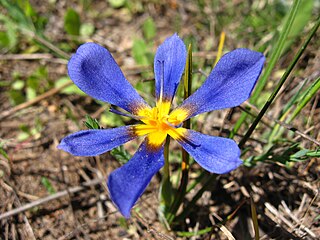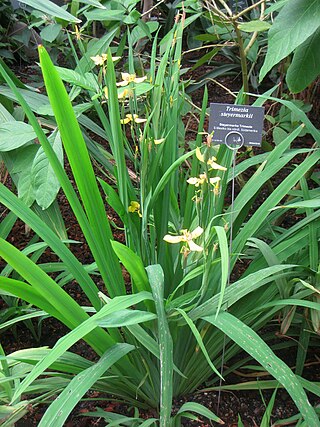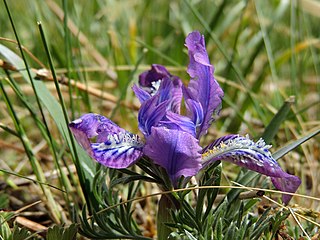
Iridaceae is a family of plants in order Asparagales, taking its name from the irises. It has a nearly global distribution, with 69 accepted genera with a total of c. 2500 species. It includes a number of economically important cultivated plants, such as species of Freesia, Gladiolus, and Crocus, as well as the crop saffron.

Tigridia, is a genus of bulbous or cormous flowering plants belonging to the family Iridaceae. With common names including peacock flowers, tiger-flowers or shell flowers, they have large showy flowers; and one species, Tigridia pavonia, is often cultivated for this. The approximately 60 species in this family grow in the Americas, from Mexico down to Chile.
Khangai is a sum (district) of Arkhangai Province in central Mongolia. In 2009, its population was 2,926.

Nemastylis, or pleatleaf, is a genus of flowering plants in the family Iridaceae, first described as a genus in 1835. It is native to Mexico, Central America, and the southern part of the United States. The genus name is derived from the Greek words nema, meaning "thread", and stylos, meaning "pillar" or "rod".

Tigridia pavonia is a species of flowering plant in the iris family Iridaceae. Common names include jockey's cap lily, Mexican shellflower, peacock flower, tiger iris, and tiger flower. This summer-flowering bulbous herbaceous perennial is widespread across much of Mexico, Guatemala, El Salvador, and Honduras. It is naturalized in Ecuador and Peru.

Iridoideae is one of the two main subfamilies in the popular family Iridaceae. It contains the best-known genus - Iris. The members of this subfamily are widely distributed worldwide. They grow in all continents except Antarctica.

Crocoideae is one of the major subfamilies in the family Iridaceae.

Irideae is a tribe included in the well-known family Iridaceae. It contains many species in five genera which are widely distributed in the Old World. The tribe derives its name from Iris, which is the largest genus of the tribe.

Trimezieae is a tribe included in the subfamily Iridoideae of the family Iridaceae. It is the smallest tribe in this subfamily, containing only three closely related genera.

Watsonieae is the second largest tribe in the subfamily Crocoideae and named after the best-known genus in it — Watsonia. The members in this group are widely distributed in Africa, mainly in its southern parts.

Sisyrinchieae is the second largest tribe in the subfamily Iridoideae. The group is included in the family Iridaceae. It contains many perennials which are widely distributed in the New World.

Calydorea is a small genus of perennial, herbaceous and bulbous plants in the family Iridaceae native to Mexico and South America. The plants in the genus are small with tunicated bulbs. The flowers are light blue, violet, white, or yellow, depending on the species, of which there are around twenty. Taxonomists considered that the already known genera Salpingostylis, Cardiostigma, Catila and Itysa are not enough different from each other to justify their taxonomic segregation and, for this reason, all of them are now included in Calydorea.

Trimezia is a genus of flowering plants in the family Iridaceae, native to the warmer parts of southern Mexico, Central America, South America, Florida, and the West Indies. Trimezia is placed in the tribe Trimezieae. The division of the tribe into genera has varied considerably. In one approach, it contains only the genus Trimezia, which then includes the genera Neomarica, Pseudotrimezia and Pseudiris. In other approaches, two to five genera are recognized, sometimes also including the genus Deluciris.
Iris bloudowii is a species in the genus Iris. It is also in the subgenus of Iris and in the Psammiris section. It is a rhizomatous perennial, from Russia, Siberia, Kazakhstan, Mongolia and China, with sickle-shaped leaves, slender stem and 2 bright or pale yellow flowers. It is cultivated as an ornamental plant in temperate regions.

Iris humilis is a plant species in the genus Iris. It is also in the subgenus of Iris and in the Psammiris section. It is a rhizomatous perennial, with a wide distribution range from Europe to Russia to China, via Mongolia and Kazakhstan. It has sword-shaped leaves, a short stem and yellow flowers with an orange beard. It is cultivated as an ornamental plant in temperate regions.

Iris potaninii is a species in the genus Iris; it is also in the subgenus of Iris and in the Psammiris section. It is a rhizomatous perennial, from Siberia in Russia, Mongolia and China. It is a dwarf plant, having either subterranean or very small stems, long thin leaves and yellow, or dark violet to purplish blue flowers. It is cultivated as an ornamental plant in temperate regions.
Iris ivanovae is a plant species in the genus Iris and part of the subgenus Iris and in the section Pseudoregelia. It is a rhizomatous perennial, from eastern Russia, China, and Mongolia.

Iris tigridia is a plant species in the genus Iris; it is also in the subgenus Iris and in the section Pseudoregelia. It is a rhizomatous perennial, from Kazakhstan, Russia, Mongolia and China. It has dark green or greyish green, grass-like leaves, a short slender stem and a single flowers that are either violet, dark blue, blue-purple, dark purple, mauve, lilac, lavender, or light purple. It is cultivated as an ornamental plant in temperate regions.

Iris glaucescens is a plant species in the genus Iris and subgenus Iris. It is a rhizomatous perennial, found in Russia, Kazakhstan, Mongolia and China. It has blue-grey sickle-shaped leaves, slender stem, and spring flowers in blue-violet, pale violet, lilac-purple, to deep purple, to light bluish, and almost white shades. It is rarely cultivated as an ornamental plant in temperate regions. It was merged with another similar iris in the region, and became a synonym of Iris scariosa, before being divided into two separate species again, although some sources still call it a synonym of Iris scariosa.

The genus Chalepogenus, consisting of 21 species of solitary oil-collecting apid bees, demonstrates oligolecty by foraging on oil-producing flowers from the families Calceolariaceae, Iridaceae and Solanaceae. These oil-flowers are abundant in South America, where Chalepogenus is endemic. In contrast to honey bees, Chalepogenus species do not collect nectar; instead, they gather floral oil for various purposes, including provisioning their larvae, constructing nests, and sustaining foraging adult bees. Although oil collection has been reported to be performed by females only, both males and females have specialised oil-collecting structures.
















